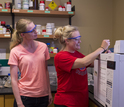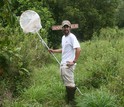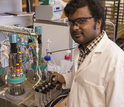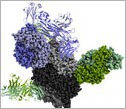News Release 17-071
NSF EPSCoR awards new projects to help understand connections between genes and organisms' characteristics
New awards focus on genotype-to-phenotype relationship
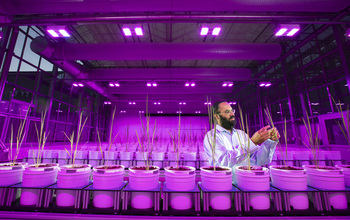
The University of Nebraska-Lincoln's project focuses on ensuring global food security.
August 2, 2017
This material is available primarily for archival purposes. Telephone numbers or other contact information may be out of date; please see current contact information at media contacts.
The National Science Foundation (NSF) has made eight awards totaling $41.7 million for projects aimed at building capacity to research a national priority area: understanding the relationship in organisms between genetic material, or genotype, and physical characteristics due to gene expression and environmental influences, or phenotype.
The genotype-to-phenotype relationship has significant societal and economic implications across scientific fields and areas of industry, including but not limited to medicine, agriculture, biotechnology and ecology. An enhanced understanding of this relationship holds the potential for improved food crop yields, better prediction of human disease risk and new drug therapies. Through these investments, NSF aims to provide the scientific community with new tools and resources for future discoveries.
"Over the past several decades, scientists and engineers have made massive strides in decoding, amassing and storing genomic data," said Denise Barnes, Head of NSF's Established Program to Stimulate Competitive Research (EPSCoR) Program. "But understanding how genomics influence phenotype remains one of the more profound challenges in science. These awards lay the groundwork for closing some of the biggest gaps in biological knowledge and developing interdisciplinary teams needed to address the challenges."
The awards are made through NSF EPSCoR as part of its Research Infrastructure Improvement (RII) Track-2 investment strategy. RII Track-2 is intended to build national research strength by initiating research collaborations across institutions in two or more EPSCoR jurisdictions. The four-year awards involve 21 institutions in 16 eligible jurisdictions.
EPSCoR is a program designed to fulfill NSF's mandate to promote scientific progress nationwide. Currently, 24 states, the Commonwealth of Puerto Rico, the U.S. Virgin Islands and Guam are eligible to compete for EPSCoR RII funding. Through this program, NSF establishes regional partnerships with government, higher education and industry that create lasting improvements in a state's or territory's research infrastructure and research and development capacity.
Each of the new awards will support research and require recipient institutions to invest in developing a highly skilled, diverse workforce -- particularly early-career faculty researchers -- that can sustain research development in science, technology, engineering and mathematics (STEM) both in academia and in industry.
This year's eight awards are for four years each and involve 21 institutions in 16 EPSCoR-eligible jurisdictions.
The project titles, principal investigators and lead institutions are listed below.
Using Natural Variation to Educate, Innovate, and Lead (UNVEIL): A collaborative research network to advance genome-to-phenome connections in the wild: Zac Cheviron, University of Montana
This project capitalizes on complementary research strengths at the University of Montana and the University of Nebraska-Lincoln to address fundamental scientific questions that can advance understanding of how organisms function in complex environments and how they acclimate and adapt to environmental challenges. The team seeks to use newly developed genomic technologies to understand the genetic basis of traits that influence the survival of wild animals and plants in changing environments. Their findings will have major implications that extend to conservation biology, agriculture and medicine.
Comparative genomics and phenomics approach to discover genes underlying heat stress resilience in cereals: Harkamal Walia, University of Nebraska-Lincoln
To ensure global food security, there is an urgent need to improve crop resilience to high night-temperature stress-induced losses to yield and quality. This project will focus on rice and wheat, which together provide more than 50 percent of caloric intake for humans worldwide. This project builds upon complementary expertise and infrastructure in Nebraska, Kansas and Arkansas for studying rice and wheat crops at the laboratory and field scales. The project will translate these discoveries into genetic and phenotypic markers for public and private breeding programs and develop a broad continuum for plant science research and education. Collaboration with key industry partners will ensure the prompt translation of promising research findings into applications that can benefit farmers.
Genome to fitness: An analysis of the stress response in Peromyscus: Hippokratis Kiaris, University of South Carolina at Columbia
This collaborative project involving the University of South Carolina, Claflin University and Auburn University aims to dissect the genomic basis of stress response in mammals. The stress responses vary among cells and tissue types and the impact of these responses on animals' functions and survival is not well understood. This project applies a combination of genomic analyses coupled with stress tests at cellular and organismal levels to understand the fitness of mammals. The research will use the North American deer mouse as a model.
Advanced biomanufacturing: Catalyzing improved host development and high-quality medicines through genome to phenome predictions: Sarah Harcum, Clemson University
This project brings together Clemson University, the University of Delaware, Tulane University and Delaware State University to study the basis for genomic instability in ovary cell lines, using the Chinese hamster as the organism for study. The study aims to expand the quantitative understanding of the complex interactions between the genome and environment that generates variable phenotypes. A lack of understanding of the fundamental link between genome stability and the phenome significantly limits the ability to improve cell lines. This study will provide foundational genotype-phenotype knowledge to overcome those limitations, thus solving biopharmaceutical manufacturing challenges to improve medicines and patient access to medicines.
Using biophysical protein models to map genetic variation to phenotypes: Frederick Ytreberg, University of Idaho
One of the great challenges in modern biology is understanding how changes in amino acids that are the building blocks of proteins lead to changes in the characteristics of a living organism. This project tackles this aspect of the genotype-phenotype challenge by focusing on protein biophysical models and using a diverse set of experimental systems, molecular and mathematical modeling. The project builds upon complementary expertise and infrastructure in Idaho, Vermont and Rhode Island. The research has significant societal implications for its potential to lead to advances in biotechnology and health sciences.
Building Genome-to-Phenome Infrastructure for Regulating Methane in Deep and Extreme Environments (BuG ReMeDEE): Rajesh Sani, South Dakota School of Mines and Technology
Globally, about 60 percent of methane emissions are related to human-caused activity. Most of those human-related emissions are attributed to microbes involved with the decomposition of biomass, including waste in landfills and sediment at the bottom of bodies of water. However, a large gap in scientific knowledge is associated with methane cycles in deep, extreme areas of Earth's biosphere. The BuG ReMeDEE consortium brings together experts from South Dakota School of Mines and Technology, Montana State University and University of Oklahoma to investigate methane cycling in such environments and develop new biological mechanisms for converting methane into value-added products.
Genomic logic underlying adaptive morphological divergence: Riccardo Papa, University of Puerto Rico -- Rio Piedras
Understanding the genotype-phenotype relationship is an important goal for evolutionary biology, but it remains a challenge due to the complexity of interpreting the connections between networks of interacting genes and evolutionary development mechanisms. This project builds on the complementary expertise of the University of Puerto Rico-Rio Piedras and Mississippi State University and uses butterfly wing color patterns as a mechanism to study genotype-phenotype relationships in Heliconius butterflies. Disentangling these relationships will provide a major advance in understanding how morphological diversity develops and ultimately originates, which would inform research into other organisms.
G2P in VOM: An experimental and analytical framework for genome to phenome connections in viruses of microbes: Eric Wommack, University of Delaware
The proposed research will test genome to phenome hypotheses in viruses of microbes, focusing on phenomic features influencing viral impacts within ecosystems. Viruses are now known to play important and possibly indispensable roles in the biology and ecology of cellular organisms. Most viruses observed within ecosystems infect microbes. During infection, viruses can alter the phenome of host cells in ways that change the population biology of microbial communities and the flow of nutrients and energy within ecosystems. The details of these processes are largely a mystery. This project will work to connect the genomic features of viruses of microbes with phenotypic life-history traits, using these connections to advance scientific understanding about the role of such viruses in ecosystems. The team is formed by experts from University of Delaware, the University of Nebraska-Lincoln, the University of Hawaii at Manoa and a primarily undergraduate university in Rhode Island, Roger Williams University.
-NSF-
-
Each EPSCoR awards requires recipient institutions to invest in developing a skilled workforce.
Credit and Larger Version -
Riccardo Papa, of the University of Puerto Rico -- Rio Piedras, in the field.
Credit and Larger Version -
The South Dakota School of Mines and Technology's project focuses on methane cycling.
Credit and Larger Version -
Researchers in Puerto Rico study butterfly wing colors to understand genotype-phenotype connections.
Credit and Larger Version -
The University of South Carolina's Hippokratis Kiaris at work in his laboratory.
Credit and Larger Version -
The University of Idaho's project could improve computer simulations to predict amino acid changes.
Credit and Larger Version
Media Contacts
Rob Margetta, NSF, (703) 292-2663, email: rmargett@nsf.gov
The U.S. National Science Foundation propels the nation forward by advancing fundamental research in all fields of science and engineering. NSF supports research and people by providing facilities, instruments and funding to support their ingenuity and sustain the U.S. as a global leader in research and innovation. With a fiscal year 2023 budget of $9.5 billion, NSF funds reach all 50 states through grants to nearly 2,000 colleges, universities and institutions. Each year, NSF receives more than 40,000 competitive proposals and makes about 11,000 new awards. Those awards include support for cooperative research with industry, Arctic and Antarctic research and operations, and U.S. participation in international scientific efforts.
Connect with us online
NSF website: nsf.gov
NSF News: nsf.gov/news
For News Media: nsf.gov/news/newsroom
Statistics: nsf.gov/statistics/
Awards database: nsf.gov/awardsearch/
Follow us on social
Twitter: twitter.com/NSF
Facebook: facebook.com/US.NSF
Instagram: instagram.com/nsfgov

